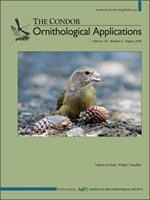Eastern hemlock (Tsuga canadensis) is undergoing widespread decline throughout the eastern United States due to the introduction of the nonnative hemlock woolly adelgid (Adelges tsugae). In light of hemlock's unique significance for avian communities, we examined the long-term response of the breeding bird community to the decline and die-off of this foundational forest species. We conducted variable-radius point counts to survey bird communities in both hemlock and hardwood stands in 2000, during the early stages of adelgid infestation, and again in 2015 and 2016, following significant hemlock decline. We also measured the severity of hemlock decline and associated vegetation variables in the same hemlock stands in which avian surveys were completed. We used multispecies occupancy models to examine species-specific and species group responses to hemlock decline. Results showed that, across hemlock stands, hemlock basal area declined from a mean of 56% of the total basal area to 46%, and that hemlock decline was correlated with current vegetation structure, including an increased deciduous understory. Species richness of hemlock-associated birds declined by an average of ∼1 species per survey location. The Black-throated Green Warbler (Setophaga virens) was the most strongly affected, declining in occupancy by 30%. All other species groups responded positively, with the strongest responses by species associated with the shrub layer, forest edge, and mature deciduous habitat. The species composition in hemlock and hardwood stands became more similar over time as the unique species assemblages in hemlock stands gave way to the avian community of the surrounding hardwood landscape, highlighting a trend toward homogenization of the avian community. Where hemlock-associated bird species persisted, their presence was correlated with a combined effect of greater hemlock basal area and better hemlock condition. Our results demonstrate that the decline of hemlocks has restructured vegetation communities and their associated avian communities over time, with strong implications for forest-specialist birds.
How to translate text using browser tools
23 May 2018
Shifts in vegetation and avian community structure following the decline of a foundational forest species, the eastern hemlock
Matthew J. Toenies,
David A. W. Miller,
Matthew R. Marshall,
Glenn E. Stauffer

The Condor
Vol. 120 • No. 3
August 2018
Vol. 120 • No. 3
August 2018
Adelges tsugae
birds
community
decline
Empidonax virescens
occupancy
Setophaga virens




